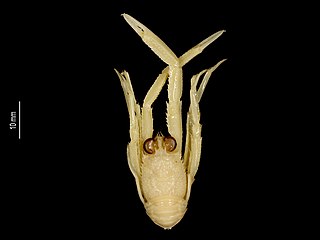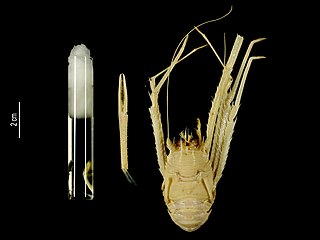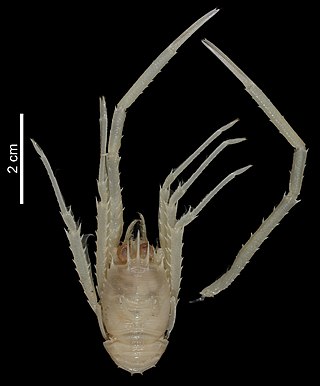
Squat lobsters are dorsoventrally flattened crustaceans with long tails held curled beneath the cephalothorax. They are found in the two superfamilies Galatheoidea and Chirostyloidea, which form part of the decapod infraorder Anomura, alongside groups including the hermit crabs and mole crabs. They are distributed worldwide in the oceans, and occur from near the surface to deep sea hydrothermal vents, with one species occupying caves above sea level. More than 900 species have been described, in around 60 genera. Some species form dense aggregations, either on the sea floor or in the water column, and a small number are commercially fished.

Agononida is a genus of squat lobsters in the family Munididae. In 2022, recognizing that the genus as then defined was paraphyletic, it was divided into three lineages: Agononidasensu stricto and two new genera, Garymunida and Hexamunida. Agononida is distributed in the Indian and Pacific Oceans.

Babamunida is a genus of squat lobsters in the family Munididae. The genus occurs in the Atlantic, Indian, and Pacific Oceans, with the greatest diversity in the Pacific.

Heteronida is a genus of squat lobsters in the family Munididae. They occur in the western Pacific Ocean.

Plesionida is a genus of squat lobsters in the family Munididae. As of 2017, it contains the following species:

Sadayoshia is a genus of 15 species of squat lobsters in the family Munididae.

Torbenella is a genus of squat lobsters in the family Munididae. They occur in the western Pacific Ocean.

Munididae is a family of squat lobsters, taxonomically separated from the family Galatheidae in 2010.

Torbenella insolita is a species of squat lobsters in the family Munididae. It occurs in the Pacific Ocean from Tonga to Papua-New Guinea and New Caledonia at depths between 120–470 m (390–1,540 ft).

Torbenella calvata is a species of squat lobsters in the family Munididae. The species name, calvata, comes from the Latin word calvatus, meaning made bare. This is in reference to its lack of spines on the anterior ridge of the second abdominal segment.

Garymunida aequabilis is a species of squat lobster in the family Munididae. It occurs in the Pacific Ocean. The specific name is derived from the Latin aequabilis, meaning "equal", or "similar", in reference to its similarity to Garymunida pilosimanus.

Garymunida garciai is a species of squat lobster in the family Munididae. It occurs in the western Pacific Ocean near New Guinea and Fiji. The specific name is in reference to Antoni García Rubies.
Garymunida imitata is a species of squat lobster in the family Munididae. It occurs in French Polynesia. The specific name is derived from the Latin word imitatus, meaning "copy" or "mimic," which is in reference to its similarity to Agononida soelae.

Garymunida simillima is a species of squat lobster in the family Munididae. It occurs in French Polynesia. The specific name is derived from the Latin similis, which refers to its similarity to Agononida normani. The males measure from 12.4 to 13.5 millimetres and the females from 4.6 to 14.6 millimetres. It is found off of the Austral Islands, at depths between 200 and 1,000 metres.
Babamunida debrae is a species of squat lobster in the family Munididae. It was discovered on the west coast of Hawaii, usually sheltering in holes of lava rocks.
Hendersonida is a monotypic genus of squat lobsters in the family Munididae. Its only member is H. granulata. The genus name is in reference to John Robertson Henderson. Hendersonida is found off of the Philippines, Indonesia, Queensland, New Caledonia, Loyalty Islands, Fiji, Tonga, Futuna Island, Vanuatu, Wallis Islands, and Bayonnaise Bank, at depths between about 395 and 650 metres.

Hexamunida is a genus of squat lobsters in the family Munididae. It was erected in 2022 when the then paraphyletic Agononida was divided into three lineages: Agononidasensu stricto and two new genera, Garymunida and Hexamunida. The genus name refers to the number of spines (six) along the anterior ridge of the second abdominal somite, whereas these spines number four in Agononida.

Garymunida is a genus of squat lobsters in the family Munididae. It was erected in 2022 when the then paraphyletic Agononida was divided into three lineages: Agononidasensu stricto and two new genera, Garymunida and Hexamunida. The genus name honors Gary C. B. Poore, acknowledging his "significant contributions to the study of the Galatheoidea and other crustaceans".

Scolonida is a small genus of squat lobsters in the family Munididae. It was erected in 2022 to accommodate three species previously placed in the genus Munida. The genus name combines the Greek scolos (=spine) and the genus name, Munida, and refers to the presence of protogastric spines that characterize the genus.

Leptonida is a small genus of squat lobsters in the family Munididae. It was erected in 2022 to accommodate Munida delicata, now Leptonida delicata, in a major revision of the genus Munida. At the time, it was monotypic, but the World Register of Marine Species lists another species not mentioned in the 2022 revision. Leptonida delicata occurs in south-western Pacific Ocean.
















